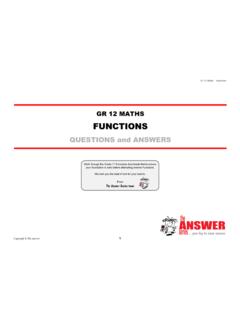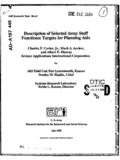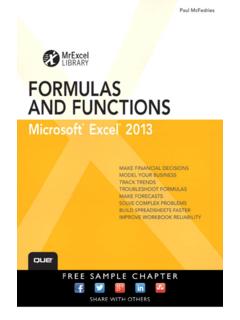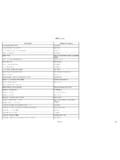Transcription of Excel Formulas & Functions - kingofalltechnology.com
1 Excel Formulas & Functions Tips & Techniques Excel makes use of Formulas (mathematical expressions that you create) and Functions (mathematical expressions already available in Excel ) to dynamically calculate results from data in your worksheets. Constructing a formula To start entering a formula in a cell, click in that cell and then type the formula. Type return or tab to move to the next cell when you have finished entering the formula. All Formulas begin with the = symbol. All Formulas use the following mathematical operators: o * multiplication o / division o + addition o - subtraction Formulas containing numbers will produce a result that will not ever change.
2 O The formula =3*8 produces the result 24. However, a formula containing cell references produces a result that may change if the data in those cells changes. o The formula =C3+D3 will produce a result based upon the data in cells C3 and D3. 1. Using the order of mathematical operations All Formulas utilize the standard mathematical order of operations when calculating results. If a part of a formula is in parentheses, that part will always be calculated before the rest of the formula. o The formula =(B2*C2)-A3 will subtract data in cell A3 from the multiplied product of cells B2 and C2.
3 After expressions in parentheses, Excel will calculate your formula using the math operators in the following order o Multiplication o Division o Addition o Subtraction In other words, Excel will begin to parse your formula starting with any multiplication and division. Once this is complete, Excel will add and subtract the remainder of your formula. Inserting a function Each of Excel 's Functions is a predefined formula, and most act on a range of cells that you select. ( Excel refers to each range of cells in the function as an argument.)
4 Although a few Functions do not use arguments, most have one or more and some complex Functions use as many as 3 or 4 arguments. Excel provides a Paste Function window to simplify the process of inserting Functions into your worksheets and eliminate the need to remember the exact syntax of each function. Select the cell into which you want to insert a function. From the Insert menu, choose Function. Alternatively, you can click on the Paste Function button on the standard toolbar. 2. In the Paste Function window, click on the function category containing the function you want.
5 Next, click on the name of the function you wish to insert. Once you have selected a function, click OK. Next, Excel will display a syntax window to help you construct the function. From this window, first click on the collapse button (labeled with a red arrow) to the right of the box labeled Number1 or Value1 (depending on the function you chose to insert). Drag to select the range of cells to be included as the function's first argument. Type enter. To insert additional arguments into the function, follow this process using the other Number boxes in the syntax window.
6 When you have finished, click OK in the syntax window to insert the function into your worksheet. 3. Searching for help on Functions From the Paste Function window, Excel offers help on a function that you have selected as well as help finding the function that will perform a task you describe. Getting help on a specific function To get help on a specific function, click on the function's name at the right of the Paste Function window and then click on the Help button at the window's lower left. Click on Help with this feature in the yellow callout box that appears, and then click on Help on selected function in the callout box that appears next.
7 Excel will display its Help topic on the function that you selected. 4. Finding a function From the Paste Function window, click on the Help button in the lower left corner, and then click on Help with this feature in the yellow callout box that appears. In the box at the bottom of the next yellow callout box, type a description of the calculation you wish to perform. Click on Search. Excel will display a list of Functions that may meet your criteria in the Recommended list at the right of the Paste Function window. To learn more about one of these Functions , click on its name and then click Help on selected function.
8 5. Using Functions with external data Although most Functions utilize data on the same worksheet, you can also use data on other worksheets or in other. In this way, you can consolidate data from multiple sources into an executive summary. Before beginning, open any workbooks that contain data to be used in your function. Select the cell into which you want to insert a function. Open the Paste Function window, click on the name of the function you wish to insert, and click OK. Collapse the gray syntax window, using the collapse button (labeled with a red arrow).
9 Navigate so that the worksheet or workbook containing your data is visible on your screen. Drag to select the range of cells to be included as the function's first argument. Type enter. Excel will insert the reference to the cells that you selected (including the name of the external worksheet and workbook) into your function. Click OK to finish your function. Tip: Naming external data ranges When you select a range of cells on an external worksheet, Excel will add the name of your external worksheet to the cell range reference that it creates.
10 In the example above, Excel refers to the selected cells (from the expenses worksheet) as expenses!D5:D15. If those cells were in an external workbook, the name of that workbook would preface the worksheet name. In general, references to external data look like this: [workbook ]worksheet name!C1:C34. 6. Tip: Using external data in Formulas Use this technique to insert external data in your Formulas , as well. When creating a formula, navigate to the external worksheet containing your and click to select that cell's data for use in your formula.








